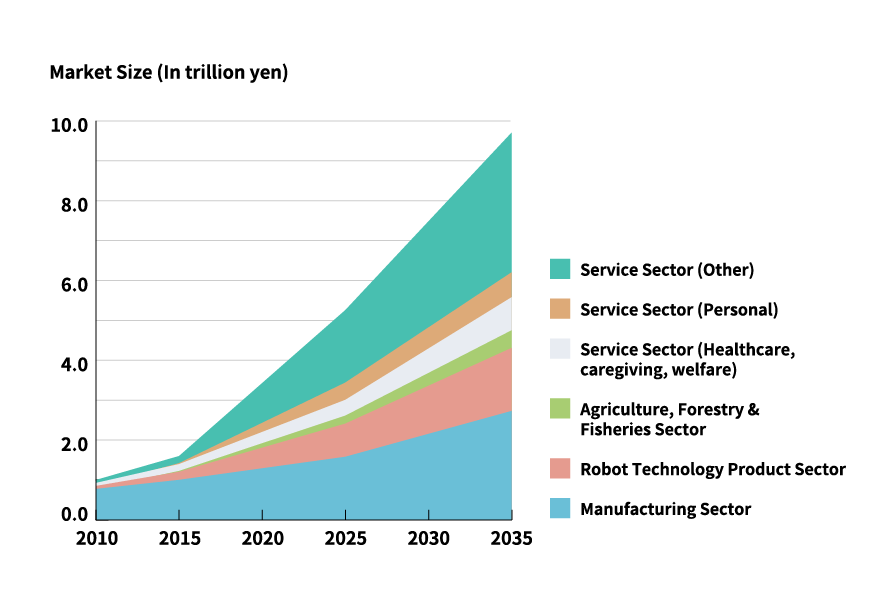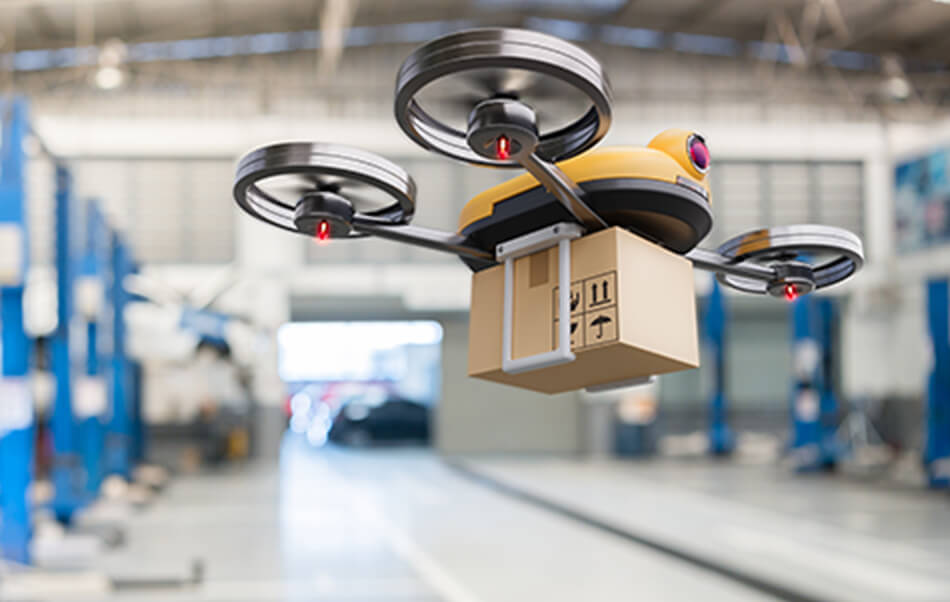
A world where we work, learn, play, relax, and eat with robots every day
Robotics and the Work Productivity Revolution
Societal Issues in Japan and Around the World
The annual birthrate in Japan is falling faster than previously forecasted. According to annual figures in Japan’s vital statistics, the number of live births in 2019 was 864 thousand, falling below 900 thousand for the first time since such statistics were first collected in 1899. This drop in live births to 860 thousand occurred two years sooner than the previously estimated by the National Institute of Population and Social Security Research, and came as a shock to society. While Prime Minister Shinzo Abe deemed the situation a “national crisis” and pointed to the necessity of taking actions, so far no actions have proven to be effective. Japan has undeniably reached the stage of a super-aged society linked to its low birthrate.
According to data from the Japan Productivity Center, in 2018 Japan ranked 21st in productivity (per-hour, based on added-value) among the 36 member states of the Organization for Economic Cooperation and Development. Japan’s productivity was rated at slightly over 60% of that of the United States and less than half of that of Ireland, the country at the top of the list.
Declining population, aging society, and falling productivity are all problems that can sap economic and social vitality. Robotics has the potential to offset this looming downward trajectory.
Over a decade ago in 2009, MRI carried out a project commissioned by the New Energy and Industrial Technology Development Organization (NEDO) entitled Creating a Robotics Industry & Market: Research & market analysis of domestic & global trends in technology. The project report began with the following statement: “We forecast growth for the robotics industry for two primary reasons. First, the robotics industry will provide a means to address the decreasing workforce and increasing workload. Second, robotics will allow for to improvements in product quality, service quality, and overall productivity. We also foresee the application of robotics, one of Japan’s strengths, to resolve issues in areas beyond manufacturing such as in households, caregiving, and welfare.”
The report included case studies of robotics, interviews with a variety of sources, discussions with front-line robotics experts, and meticulous market-size estimations. Specific estimates included our forecast for market size to reach 9.7 trillion yen in 2035 (Figure). These figures are still used as reference data for the robotics market.
It has been ten years since this report was filed. While the growth in manufacturing has largely followed predictions made in the 2019 report, the service sector has lagged behind. We originally predicted widespread introduction of robotics to the service sector and a market size double that of manufacturing by 2025.
2009 Forecast of Japanese Robotics Industry through 2035

Source: New Energy and Industrial Technology Development Organization FY2009 Project “Creating a Robotics Industry & Market: Research & market analysis of domestic & global trends in technology” (commissioned to MRI) Final Project Report (March 2010).
Factors Preventing the Spread of Robot Use in the Service Sector
There are three primary factors that have hindered the spread of robot technology in the service sector
- ・First, technological advancements and the application of new technologies have taken precedence over user needs in robot development, resulting in a lack of robots featuring sufficient usability and market demand.
- ・Second, previous robot technology has not been advanced enough for application in real-life situations.
- ・Third, there has been a lack of sufficient safety measures, standards, and regulations.
Recently, however, these issues are starting to be resolved with the following solutions.
For the first issue, needs-oriented development has become more common. User needs for robotics have become more clear in light of an increasingly severe shortage of workforce and recent work-style reforms. Also, robot developers are increasingly aware of the limitations of focusing only on the advancements and new applications of technology itself.
For the second issue, rapid advancements have been made in the level of technologies required for the application of robots in real-life situations. Advancements in technologies for visual and tactile sensors, high-speed data transmission such as 5G, IoT and AI, in particular, have been staggering. We will take a closer look at these technologies in subsequent articles of this column.
For the third issue, standards and regulations are being developed specifically for robotics such as the ISO 13482, an international standard for personal care robots.
As a result, advancements in the above three fields represent the people, technology, and policies necessary for the widespread application of robotics. In a subsequent stage, it will be necessary for robot developers to predict changes to the social and business environments, test use cases designed to resolve potential issues, and develop products that are more widely accepted.
Robots of the Past and Future

The Japanese Industrial Standards (JIS), meanwhile, offers the following definition: “an industrial machine with automatically controlled manipulation or movement functions capable of performing different tasks through programmed motions” (from JIS B 0134).
The “Japan’s New Robot Strategy - Vision, Strategy, Action Plan,” which was developed in 2015 based on the discussions at the Robot Revolution Realization Council*1 then identified the following three defining features of the ongoing dramatic transformation of robots: 1) “autonomous” - learning by themselves and taking action; 2) “information terminal device” - collecting and using a wide variety of data by themselves; and 3) “networked” - interconnected for mutual cooperation among robots. The final characteristic, “networked”, provided a particularly unique element to the definition.
The NEDO Robotics White Paper 2014 remarked that definitions of a robot are fluid, since “science and technology, as well as industrial structures, social systems, and culture change with time. The roles played by robots and how they are perceived too change accordingly.”
As a result of the discussions that have been made over the years, people have come to think of robots in a more free and flexible manner. Today, a robot can be something that has an ability to learn by itself without a manipulator or mobility system, or one that stores and uses various information. For instance, software technologies such as robotic process automation (RPA*2) are considered robots, and drones are considered a form of robots that are autonomous and networked. IoT-based home appliances and self-driving cars also use robotics and are also considered robots in the broad sense.
Areas for Application of Robotics Covered in MRI’s Advanced Technology Megatrends
Taking into consideration the most advanced technologies at present, MRI has identified and analyzed trends in six potential areas for widespread use of robotics: caregiving, agriculture, education & sports, logistics, retail & dining, and offices. MRI used the following criteria when identifying the six potential areas: 1) areas facing manpower shortages on the supply side in spite of large societal needs; 2) areas in need of higher productivity; and 3) areas that require problem-solving on a global scale.
For these six areas, we made estimates of what a society where robotics flourishes would be like in 2030 and 2040. For 2030 estimates, we worked under the assumption that current emerging technology will be in common use in 2030, and we envisioned the robots and society that would result from those technologies in 2030. As for 2040, we first imagined what the society would be like, then created a picture of the robots that would play an important role in such a society. We also aimed to maintain continuity between our 2030 and 2040 estimates. Where necessary, we also envisioned social systems and infrastructural reforms that would be required in order to widely use these robots.
One defining feature of our forecasting process this time was that it was led by a team of our mid-level and younger researchers whose expertise was in fields other than robotics. This allowed us to paint a novel picture of the future beyond the commonly defined boundaries of robotics. The resulting forecast is unlike any of the other existing forecasts on robotics and society.
Robotics will change our way of life, institutions, and society, similar to the recent effects of mobile phones and digital cameras. At MRI, we will continue to strive not only to become more proficient in robotics but also to bring robotics to society, thus helping create a desirable world of the future and resolving societal issues. We look forward to sharing our insight in a series of forthcoming articles.
- *1: Established based on the “Robot Revolution” declaration presented by Prime Minister Abe at the 2014 Meeting of the OECD Council at Ministerial Level in Paris.
- *2: Robotic Process Automation: software robots that automate routine computer work such as online information gathering and spreadsheet-based information processing.
